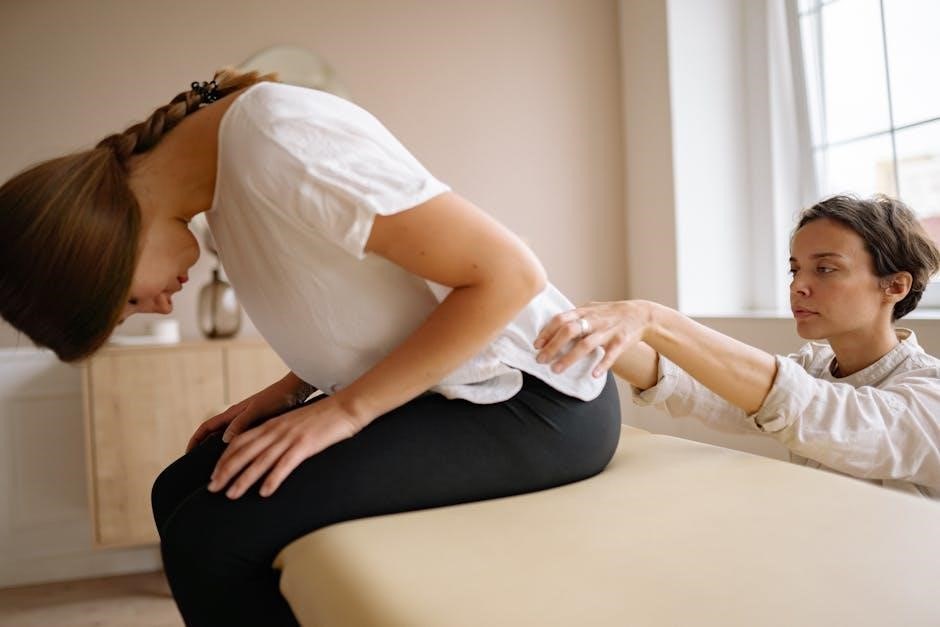Manual pelvic physical therapy is a non-invasive treatment focusing on the pelvic region, using hands-on techniques to restore function, relieve pain, and improve mobility, tailored to individual needs;
1.1 Definition and Overview
Manual pelvic physical therapy is a specialized, non-invasive approach focusing on the evaluation and treatment of pelvic-related dysfunctions. It combines hands-on techniques, exercises, and patient education to address issues like pain, muscle imbalances, and impaired mobility. This therapy targets the pelvic floor muscles, joints, and soft tissues to restore normal function and improve overall quality of life, tailored to individual needs and conditions.
1.2 Importance of Pelvic Health
Pelvic health is crucial for supporting bodily functions, posture, and overall well-being. The pelvic region plays a key role in bladder, bowel, and reproductive functions, as well as sexual health. Maintaining pelvic health prevents issues like incontinence, chronic pain, and mobility limitations. Addressing pelvic dysfunction early can significantly improve quality of life, ensuring optimal physical and emotional well-being for individuals of all ages and genders.

Benefits of Manual Pelvic Physical Therapy
Manual pelvic physical therapy offers relief from pelvic pain, enhances muscle function, and improves bladder and bowel function.
Promoting overall wellness and mobility.
2.1 Relief from Pelvic Pain
Manual pelvic physical therapy effectively reduces chronic pelvic pain by addressing muscle tension, joint dysfunction, and soft tissue restrictions.
Techniques like soft tissue mobilization and joint alignment restore normal movement patterns, decreasing discomfort and improving mobility.
This approach also enhances blood flow and relaxation, offering long-term pain relief and improved quality of life for individuals.
2.2 Improvement in Pelvic Floor Muscle Function
Manual pelvic physical therapy strengthens and restores pelvic floor muscles, enhancing their coordination and endurance.
Techniques like soft tissue mobilization and targeted exercises improve muscle tone, reducing symptoms of weakness.
This leads to better bladder and bowel control, addressing issues like incontinence and promoting overall pelvic health through tailored, evidence-based interventions.
2.3 Enhanced Bowel and Bladder Function
Manual pelvic physical therapy improves bowel and bladder function by strengthening pelvic muscles and enhancing nerve communication.
Techniques like soft tissue mobilization and targeted exercises help regulate bowel movements and reduce urinary leaks.
Patients often experience fewer symptoms of constipation and incontinence, leading to better pelvic health and improved quality of life with consistent treatment.
Common Techniques Used in Manual Pelvic Physical Therapy
Manual pelvic physical therapy employs techniques like soft tissue mobilization, joint mobilization, and stretching exercises. These methods help restore function, relieve pain, and enhance mobility, applied by skilled physical therapists for optimal results.
3.1 Pelvic Floor Muscle Assessment
A pelvic floor muscle assessment involves evaluating the strength, tone, and function of pelvic muscles. Physical therapists use internal and external techniques to identify imbalances, weakness, or tightness. This step is crucial for diagnosing issues like incontinence or pelvic pain, ensuring targeted treatment. The assessment guides the development of personalized therapy plans, addressing specific muscle dysfunctions to restore optimal pelvic floor function and overall well-being.
3.2 Soft Tissue Mobilization
Soft tissue mobilization is a hands-on technique used to target muscles, tendons, and ligaments in the pelvic region. It aims to reduce pain, improve flexibility, and restore normal tissue function. Gentle, sustained pressure is applied to release tension and break up adhesions. This method is particularly effective for addressing chronic pain, scar tissue, and limited mobility, promoting healing and enhancing overall pelvic floor function and movement.
3.3 Joint Mobilization and Alignment
Joint mobilization and alignment focus on improving mobility and reducing pain in the pelvic joints. Techniques involve gentle, non-invasive manipulations to enhance joint movement and restore proper alignment. This approach targets the sacroiliac and pubic joints, addressing misalignments, muscle spasms, and restricted movement. By improving joint mechanics, it helps alleviate discomfort, enhances posture, and promotes overall pelvic health, making it a cornerstone of manual pelvic physical therapy.
3.4 Stretching Exercises for the Pelvic Region
Stretching exercises for the pelvic region aim to improve flexibility, reduce muscle tension, and enhance overall mobility. Techniques target the pelvic floor, hip, and lower back muscles to alleviate tightness and discomfort. These exercises are tailored to individual needs, promoting relaxation and proper alignment. Regular stretching can also improve posture, reduce pain, and support long-term pelvic health, making it a vital component of manual pelvic physical therapy.
Conditions Treated with Manual Pelvic Physical Therapy
Manual pelvic physical therapy effectively addresses chronic pelvic pain, urinary incontinence, constipation, and pelvic floor dysfunction, including issues during pregnancy, improving overall pelvic health and function.
4.1 Chronic Pelvic Pain
Chronic pelvic pain is a persistent discomfort in the pelvic region, often affecting daily activities. Manual pelvic physical therapy addresses this by targeting muscle tension, improving circulation, and enhancing joint mobility. Techniques like soft tissue mobilization and joint alignment help reduce inflammation and restore normal pelvic function. Patients often experience significant pain relief, improved mobility, and a better quality of life through personalized treatment plans tailored to their specific needs and symptoms.
4.2 Urinary Incontinence
Manual pelvic physical therapy effectively addresses urinary incontinence by strengthening pelvic floor muscles and improving bladder control. Techniques such as targeted exercises, soft tissue mobilization, and biofeedback help restore muscle function, reducing leakage and enhancing confidence. Customized treatment plans focus on identifying and addressing underlying causes, leading to significant improvements in symptoms and overall quality of life for individuals experiencing this common condition.
4.3 Constipation and Bowel Dysfunction
Manual pelvic physical therapy helps alleviate constipation and bowel dysfunction by improving pelvic floor muscle coordination and relaxation. Techniques such as soft tissue mobilization, stretching, and joint alignment enhance bowel function, reducing symptoms of constipation. Additionally, therapy may address muscle tightness or weakness impacting bowel movements, promoting regularity and comfort. Lifestyle modifications, including postural awareness and breathing exercises, further support long-term bowel health and function.
4.4 Pelvic Floor Dysfunction During Pregnancy
Manual pelvic physical therapy effectively addresses pelvic floor dysfunction during pregnancy, often caused by increased weight and hormonal changes. Techniques like gentle mobilization and targeted exercises improve muscle coordination, reducing discomfort and preventing issues like incontinence. Therapy also enhances posture and alignment, alleviating lower back pain. Physical therapists provide personalized care to support pelvic health throughout pregnancy and postpartum, ensuring a smoother recovery and improved overall well-being for expectant mothers.

Role of a Physical Therapist in Manual Pelvic Therapy
A physical therapist specializes in assessing and treating pelvic floor disorders, creating personalized treatment plans, and educating patients on exercises and lifestyle changes for optimal recovery and health.
5.1 Initial Assessment and Diagnosis
The physical therapist begins with a comprehensive evaluation, including a review of medical history, symptoms, and lifestyle. They conduct a physical exam, assessing pelvic floor muscle strength, flexibility, and alignment. This initial assessment helps identify underlying issues, such as muscle imbalances or poor posture, guiding the development of a personalized treatment plan tailored to the patient’s specific needs and goals.
5.2 Customized Treatment Plans
Each patient receives a tailored plan addressing their unique pelvic health needs. The therapist incorporates manual techniques, exercises, and lifestyle adjustments, ensuring a holistic approach. Treatment may include soft tissue mobilization, joint alignment, and strengthening exercises, all adapted to the individual’s condition and goals. This personalized strategy aims to maximize progress and ensure sustainable improvements in pelvic function and overall well-being.
5.3 Patient Education and Empowerment
Patient education is a cornerstone of manual pelvic physical therapy, enabling individuals to understand their condition and treatment. Therapists provide insights into exercises, lifestyle adjustments, and self-care strategies to foster independence. By equipping patients with knowledge and tools, they gain confidence in managing their pelvic health, promoting long-term well-being and reducing reliance on passive treatments. Empowerment through education ensures active participation in recovery and self-management.
Expected Outcomes and Results
Manual pelvic physical therapy aims to alleviate pain, improve function, and restore mobility. Patients often experience enhanced pelvic stability, reduced symptoms, and improved quality of life.
6.1 Short-Term Goals
Short-term goals in manual pelvic physical therapy focus on reducing pain, improving mobility, and relieving muscle tension. Techniques like soft tissue mobilization and gentle exercises target these objectives, aiming for noticeable improvements in comfort and function within the first few sessions. Patients often experience enhanced bladder and bowel function, setting the foundation for long-term recovery and improved quality of life.
6.2 Long-Term Benefits
Manual pelvic physical therapy offers long-term benefits, including sustained pain relief, improved pelvic floor muscle strength, and enhanced bladder and bowel control. Patients often experience better posture, reduced muscle tension, and increased mobility. Over time, these improvements lead to a higher quality of life, empowering individuals to manage their pelvic health effectively and maintain long-lasting functional gains.

Lifestyle Modifications to Support Pelvic Health
Lifestyle changes, such as dietary adjustments, postural awareness, and stress management, play a crucial role in maintaining pelvic health and enhancing the effectiveness of physical therapy treatments.
7.1 Dietary Adjustments
Dietary adjustments are essential for supporting pelvic health, focusing on a high-fiber diet to improve bowel function and reduce constipation. Staying hydrated is crucial for soft tissue mobility and overall pelvic floor function. Avoiding irritants like caffeine and alcohol can help minimize bladder irritation and discomfort. Incorporating nutrient-rich foods, such as lean proteins and whole grains, supports muscle repair and strength. A balanced diet enhances the effectiveness of manual pelvic physical therapy and promotes long-term pelvic health.
7.2 Postural Awareness and Ergonomics
Postural awareness and proper ergonomics play a crucial role in maintaining pelvic health. Maintaining a neutral spine alignment reduces strain on pelvic muscles and joints. Poor posture can lead to uneven weight distribution, exacerbating discomfort and dysfunction. Incorporating ergonomic adjustments to workspaces and daily activities, such as chair height and monitor placement, can alleviate strain. Regular movement breaks and mindful body positioning further support pelvic stability and overall well-being, enhancing therapy outcomes.
7.3 Stress Management Techniques
Stress management is essential for pelvic health, as chronic stress can tense pelvic muscles, worsening discomfort. Techniques like deep breathing, meditation, and yoga help reduce tension and promote relaxation. These practices enhance pelvic floor muscle function and overall well-being. Regular mindfulness exercises can also improve emotional resilience, making it easier to cope with pelvic health challenges and supporting the effectiveness of manual therapy interventions.

Frequently Asked Questions
Addressing common concerns, FAQs cover what to expect during sessions, treatment duration, and whether manual therapy is painful, ensuring patients feel informed and reassured about their care.
8.1 What to Expect During the First Session
Your first session will typically involve an initial assessment to discuss your symptoms, medical history, and concerns. A physical therapist will perform a pelvic floor muscle evaluation, which may include internal or external exams to assess muscle strength, flexibility, and pain points. This session is tailored to understand your specific needs, establish a comfortable environment, and introduce you to the treatment approach. It’s a professional and empathetic process designed to address your concerns and set the foundation for your care plan.
8.2 How Long Does Treatment Typically Last?
Treatment duration varies depending on the severity of symptoms and individual needs. Typically, patients attend sessions once or twice a week, with most programs lasting several weeks to a few months. The goal is to progressively improve pelvic function and reduce symptoms over time. Consistency and adherence to the therapist’s recommendations are key to achieving optimal results and long-term relief.
8.3 Is Manual Therapy Painful?
Manual pelvic therapy is generally not painful, but some discomfort may occur during or after treatment. Techniques are gentle and tailored to individual tolerance. Patients may feel soreness, similar to muscle stiffness after exercise, which typically subsides within a day or two. Communication with the therapist is encouraged to ensure a comfortable experience and adjust techniques as needed for optimal comfort and effectiveness.
Manual pelvic physical therapy offers an effective treatment approach, enhancing mobility, strength, and overall pelvic health. It empowers patients to manage symptoms and improve quality of life effectively.
9.1 Summary of Key Points
Manual pelvic physical therapy is a non-invasive, hands-on approach that addresses pelvic pain, improves muscle function, and enhances bowel and bladder health; Techniques like soft tissue mobilization and joint alignment are commonly used. It is effective for conditions such as chronic pain, incontinence, and pregnancy-related dysfunction. Physical therapists play a crucial role in assessment, treatment, and patient education. This therapy promotes long-term pelvic health and empowers individuals to manage symptoms effectively, improving overall quality of life.
9.2 Encouragement to Seek Professional Help
Seeking professional help from a licensed physical therapist specializing in pelvic health is a proactive step toward addressing pelvic-related issues. Trained therapists provide personalized assessments, tailored treatments, and ongoing support to improve pelvic function and alleviate symptoms. Don’t hesitate to reach out if experiencing pain, discomfort, or dysfunction. Early intervention can significantly enhance quality of life and long-term outcomes. Take the first step toward reclaiming your pelvic health today.

Leave a Reply
You must be logged in to post a comment.